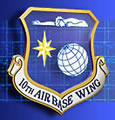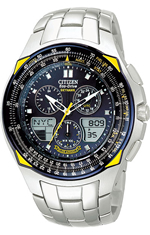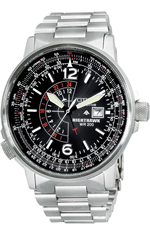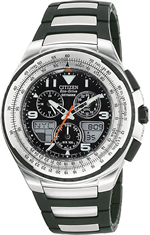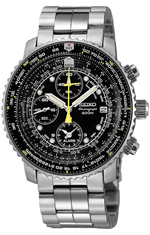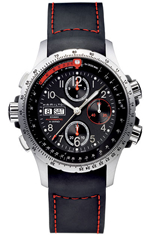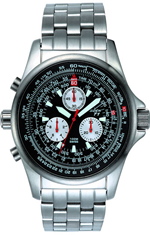THE UNITED STATES AIR FORCE ACADEMY MISSION:
To inspire and develop outstanding young men and women to become Air Force officers with knowledge, character and discipline; motivated to lead the world's greatest aerospace force in service to the nation.
HISTORY:
Youngest of the four service academies.
President Dwight D. Eisenhower signed the bill authorizing establishment of the Academy on April 1, 1954.
The first class entered in July 1955 at temporary facilities at Lowry Air Force Base, Denver. Construction of the present site also began that year.
The Cadet Wing moved into its permanent home in August 1958.
First class of 207 graduated in June 1959.
President Lyndon B. Johnson signed a bill in 1964 authorizing each of the three Academies to expand their enrollment from 2,529 to 4,417.
Current legislation limits cadet wing strength to 4,000.
First class with women entered in June 1976 and graduated in May 1980.
More than 37,800 cadets have graduated in 46 classes.
Approximately 38 percent of those commissioned in the Air Force are still on active duty.
351 graduates have been commissioned by other services; 124 by the Marine Corps, 113 by the Navy, and 114 by the Army.
292 international cadets entered and 223 have graduated from the Academy.
16 cadets have graduated posthumously.
One graduate, Capt. Lance P. Sijan, received the Medal of Honor.
403 graduates have become general officers, to include former Chiefs of Staff Fogelman and Ryan, former Air Force Academy superintendent, Lt. Gen. John R. Dallager.
164 graduates have been killed in combat.
36 graduates are repatriated prisoners of war.
Two graduates are combat aces.
33 cadets have been selected as Rhodes Scholars.
1 cadet has been selected as Alberta Bart Holaday Scholarship at Exeter College, Oxford England.
8 cadets have accepted Marshall Scholarships.
11 cadets have received the Harry S. Truman Scholarship.
92 cadets have been accepted as Guggenheim Fellows.
75 cadets have been selected as National Science Foundation Fellows.
33 cadets have accepted Fulbright-Hays Scholarships.
98 cadets have accepted scholarships to attend Harvard University's John F. Kennedy School of Government.
36 cadets have been selected as Hertz Fellows.
649 cadets have entered medical school.
ADMISSIONS CRITERIA:
Cadets must be between 17 and 22 on July 1 of the year of admission.
Each must be a U.S. citizen, unmarried and have no dependent children.
Applicants must have good grades (generally ranked in at least the top 20 percent of their high school class), be active in athletic and non-athletic extracurricular activities, and be in good physical condition.
ACADEMY EXPERIENCE:
The sum of the unique opportunities and experiences at the Academy.
Designed to allow cadets to grow militarily, intellectually, physically, and morally/ethically.
Begins with the first day of basic cadet training and ends as second lieutenants toss their hats into the air at graduation.
1. Military Development - The goal is to develop the knowledge, skills, values and behavior patterns needed to be an effective Air Force officer.
a. Military Art and Science - Designed to develop in each cadet an understanding of the military profession and the composition, heritage and employment of U.S. military power. Instruction is phased over the last three years and advances from the basics of professionalism and military theory, to air power doctrine, Air Force employment concepts; culminating with an examination of joint and multinational operational concepts. Complementary military history and political science courses are taught by the faculty.
b. Leadership - First learned as a concept and then put into practice, initially at the "follower" level. Upper-class cadets develop their leadership abilities by running the Cadet Wing, leading classroom discussions, and helping to teach Combat Survival Training and various airmanship courses. Officers are assigned to each program to advise and help.
c. Aviation Sciences and Airmanship - All cadets participate in some form of airmanship activity each of their four years at the academy. During the first summer, basic cadets are introduced to flying through orientation rides in a sailplane and the Cessna 172. Four degrees take a required aviation fundamentals course during the academic year that includes classroom instruction, T-37 simulator rides, basic navigation and a one-day field trip to an operational flying base. Three degrees participate in the Soar-for-All program, which is designed to solo each cadet through a combination of conventional and powered sailplane flights. Two degrees (Juniors) can participate in a wide range of courses in soaring, parachuting and navigation. Advanced courses in these areas prepare cadets to be instructors, permitting them to gain valuable operational and leadership experience. All cadets may belong to the Cadet Aviation Club and fly light aircraft as a member of the Aero Club during all four years. Flying activities are complemented by academic studies in astronomy, aeronautics, astronautics and physics.
d. Professional Development Program - Professional Development begins when cadets arrive to start six weeks of basic cadet training and progresses steadily over four years. Each year builds on previous training and experience. Cadets have a self-study professional development curriculum and may participate in one or two professional seminars each week. They must pass a professional knowledge review near the end of each year. Emphasis in these programs is on the duties, commitment and responsibilities of a professional officer.
2. Academic Development - Designed to provide cadets with a broad, high-quality education appropriate to a military career.
a. The Academy is recognized as one of the finest colleges in the nation. Over 2,000 graduates have received post-graduation scholarships, including Rhodes Scholarships.
b. The faculty is unique, consisting of approximately 530 military officers and civilian faculty who not only teach, but also serve as role models for cadets. About 55 percent possess a doctoral degree.
c. Cadet course load is a good deal heavier than most other colleges. The core curriculum consists of 94 semester hours, with an even balance between basic sciences and engineering sciences on one hand and social sciences and humanities on the other.
d. Cadets may choose one of 30 academic majors. About half major in science or engineering.
3. Physical Development - Objective is to develop good physical condition and the traits of teamwork, courage, aggressiveness, self-confidence, and an intense desire to win, all of which are essential to a military officer.
a. Each cadet takes 6 semester hours of physical education during four years at the Academy.
b. In addition, cadets must participate in intercollegiate or intramural sports throughout the academic year.
c. Cadets have two intramural seasons. Each squadron fields a team in 16 sports. Men and women compete as teammates in all but a few contact sports, such as boxing and football.
d. Academy fields intercollegiate teams in 17 men's and 10 women's sports.
4. Character Development - Designed to develop cadets’ professional military character through an emphasis on Air Force core values, the Cadet Honor Code, ethics instruction, human relations education and moral/spiritual development.
a. The Academy has an integrated, institution-wide character development program focusing on our core values of “Integrity First, Service Before Self, Excellence in All We Do.”
b. The foundation is the Cadet Honor Code, which states, “We will not lie, steal, or cheat, nor tolerate among us anyone who does...”
c. All cadets take a formal course in ethics and receive honor, ethics, human relations, and other character development instruction and experiences as part of their education and training program throughout their four years at the Academy.
d. The human relations education program promotes an understanding of how gender, racial, ethnic, and cultural differences affect the transition, attrition, performance, and quality of life for cadets in the Cadet Wing.
e. Cadets are afforded ample schedule opportunities to participate in faith development programs of their own choosing and are encouraged to take part in religious, spiritual, and faith activities and programs provided at the Academy.
SUMMARY:
The Academy experience is designed to:
Produce professional officers who have the knowledge, character, and motivation essential to leadership.
Offer an environment of trust and respect, where all people can achieve high productivity, are committed to organizational goals, and can reach their full potential.
Instill self-discipline and ethical accountability for one’s actions.
In short, make character central to the development of tomorrow’s Air Force leaders.
MORE INFORMATION:
Headquarters, United States Air Force Academy is supported by the 10th Air Base Wing.
Located at the base of the Rampart Range on 18,500 acres; elevation is 7,163 feet above sea level at the Terrazzo level.
Average cost to put one cadet through the four-year program is $282,562; the education portion is valued at about $123,000.
Approximately one million visitors come to the Academy annually, including up to 7,000 people per day at the Visitor Center.
Cadets are housed in two dormitories, Vandenberg Hall (1,325 rooms) and Sijan Hall (936 rooms).
Fairchild Hall contains classrooms, labs and faculty/staff offices (250 classrooms, 45 science labs, 13 lecture halls).
Mitchell Hall dining area covers 1.7 acres; staff serves the entire cadet wing at the same time, in and out in only 25 minutes.
The Air Force Academy Cadet Chapel is the 1996 recipient of the prestigious American Institute of Architects’ (AIA) Twenty-five Year Award.
Arnold Hall houses a 2,900-seat Broadway auditorium, ballroom, conference rooms, restaurant and historical displays.
Athletic fields cover 143 acres and include 18 football fields, 13 soccer fields, 10 flickerball fields; all encompassing, 2,000 people can participate in sporting events at the same time.
Cadet Field House includes the Clune Arena, used for basketball, boxing and public speaking events, seats 6,000. The Field House also has an indoor track, field area, and a hockey rink which seats 2,602.
Cadet gym is five stories tall and contains three basketball arenas, two pools (one Olympic size), 19 racquetball courts, weight rooms, four tennis courts, and offices.
THE HONOR CODE:
"We Will Not Lie, Steal Or Cheat, Nor Tolerate Among Us Anyone Who Does"
The Air Force Academy Honor Code was formally adopted in 1956 by the first graduating class, the Class of 1959. It was then, and continues to be today, a minimum standard of conduct which cadets expect of themselves and their fellow cadets.
Lt.Gen. Hubert R. Harmon, the Academy's first superintendent, established a committee of noted civilian educators and Air Force officers to study the existing honor codes and systems throughout the country and provide recommendations on a code for the Cadet Wing. The resulting Honor Code has remained virtually unchanged since its overwhelming acceptance in 1956 and has been continually administered by the Cadet Wing.
Elected representatives from throughout the Cadet Wing comprise the Cadet Wing Honor Committee. Presently there are 164 cadets on the committee two first-class cadets and two second-class cadets from each of the 36 squadrons, and the executive committee of 10 first-class cadets and 10 second-class cadets. The executive committee consists of the wing honor chairperson, wing honor education officer, wing honor NCO, the wing honor education NCO, eight group honor chairpersons, and eight group honor NCOs. Although there is an officer assigned to assist the Cadet Wing Honor Committee, the cadets administer all phases of the administrative system dealing with Honor Code violations.
The existence of the Honor Code presents many privileges and responsibilities to each cadet. A cadet's word is accepted as the truth at all times. Academic scores can truly reflect a cadet's individual effort and knowledge because of each cadet's expectance to adhere to the Honor Code. This adherence extends to a responsibility to confront other cadets on suspected violations of the Code. Such confrontations often result in a simple clarification of a misunderstanding and each cadet learns the value of clear communications in all situations.
From the moment a cadet enters the Academy they begin an education process designed to help them understand the responsibilities and expectations associated with the Honor Code. During Basic Cadet Training, cadet honor representatives conduct lessons designed to explain the Honor Code and the system to all fourth-class cadets and prepare them to take the Honor Oath at the conclusion of BCT. This oath is the formal acceptance of the Code as a part of their lives while at the Academy. Graduates are expected to use this foundation during their military service, and for the remainder of their lives.
The oath simply states, "We will not lie, steal or cheat, nor tolerate among us anyone who does. Furthermore, I resolve to do my duty and to live honorably, so help me God." The Honor Oath recognizes that honor has a broader meaning than simply not lying, stealing or cheating. True honor requires active support of positive principles rather than simple abstinence from wrongdoing. The oath also affirms the closely related nature of the concepts of honor and duty. The phrase, "so help me God," is taken from the oath of office and affirms a higher standard of living. Cadets are expected to keep the spirit of the code in all endeavors.
Despite the Academy's emphasis on integrity, some cadets put themselves in situations where their honor is called into question. If a violation of the Honor Code is suspected, an investigative team is appointed by the Group Honor Chairperson. The investigative team consists of one first- and one second-class cadet honor representative from a squadron other than the suspected cadet's. The team gathers pertinent evidence about the suspected honor violation. The investigation concludes with a review of the case by the group honor chairperson, wing honor chairperson, and the chief of the Honor Division. They review all evidence to determine whether or not the case should be forwarded to a Wing Honor Board or a Cadet Sanctions Recommendation Panel. If a cadet self-reports or admits when confronted, the case is sent to a Cadet Sanctions Recommendation Panel. If the cadet does not admit to the allegation(s), and the case is forwarded, the cadet meets a Wing Honor Board.
Board proceedings are not adversarial in nature. The suspected cadet is present during all testimony and may question any witness. There is no requirement for personal testimony by the suspected cadet, although cadets usually decide to testify in their own behalf. The Board consists of eight cadets who vote and one officer mentor who participates in the board but does not vote. The eight voting cadets are all selected at random. They hear and review all evidence and testimony under the guidance of the non-voting Group Honor Chairperson. Following the presentation of all evidence and closed deliberations, the Wing Honor Board votes by secret ballot for or against a violation. In order for a cadet to be found in violation of the Honor Code, at least six of the eight voting members of the board must be convinced beyond a reasonable doubt that the cadet was in violation of the Honor Code both by act and intent.
The presumptive sanction for an Honor Code violation is disenrollment. However, this recommendation may be suspended and the cadet placed on honor probation. If the Commandant’s recommendation is for disenrollment, the cadet may appeal to the Superintendent. At any point during the honor process, the cadet may elect to resign. The Superintendent ultimately decides if the cadet is to be disenrolled.
Cadets who live under the Honor Code agree it is a vital part of their development as military professionals. It also represents a broader aspect of ethical maturity which will serve them throughout their lives. As the bearers of the public trust, both as cadets and as officers, it is the Honor Code which helps build a personal integrity able to withstand the rigorous demands placed upon them. |




